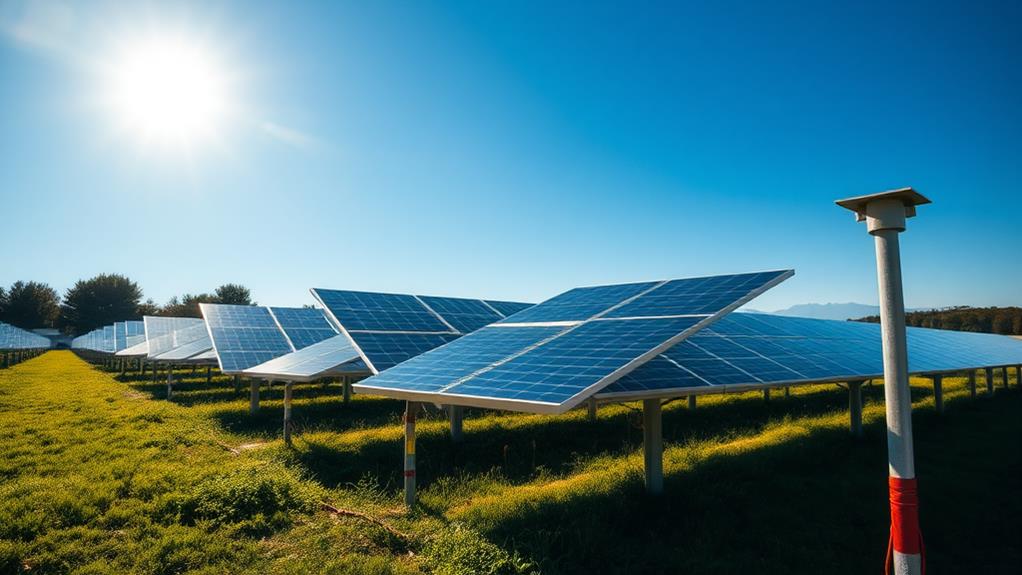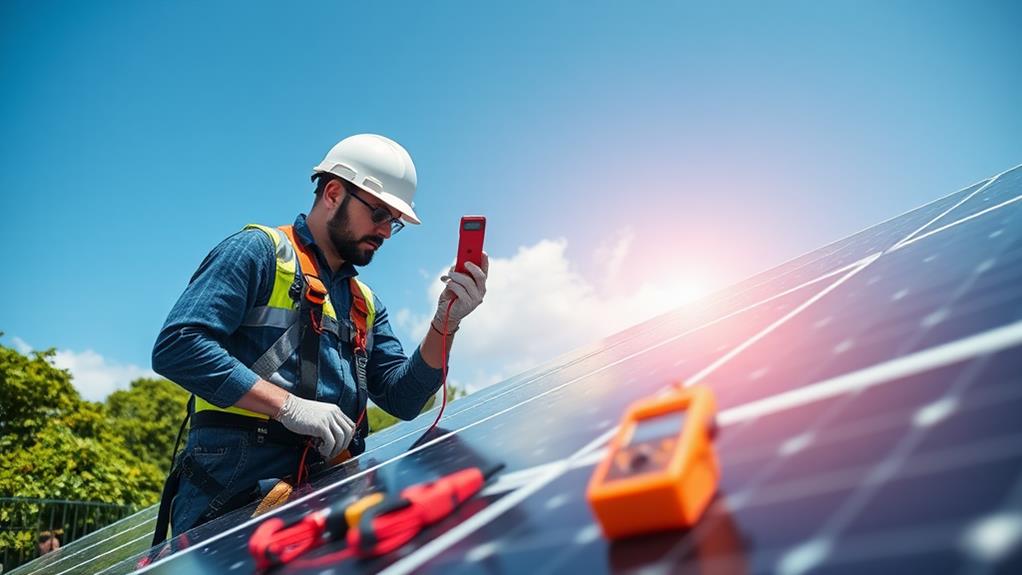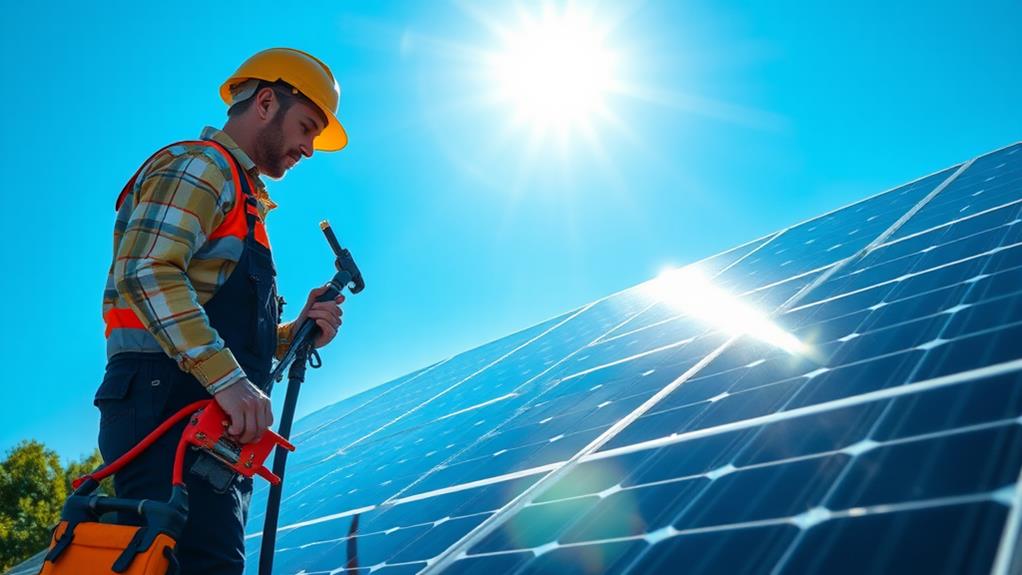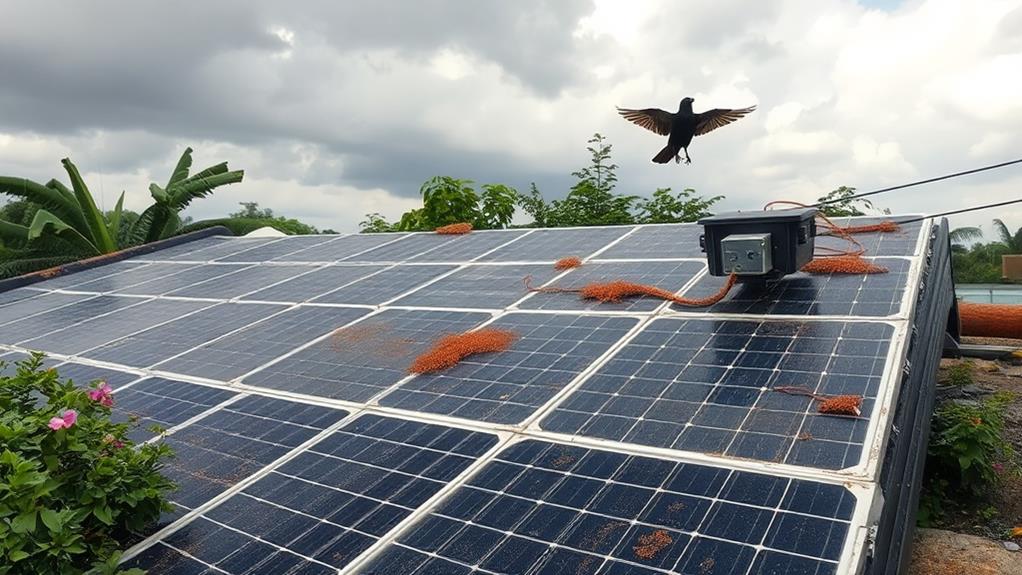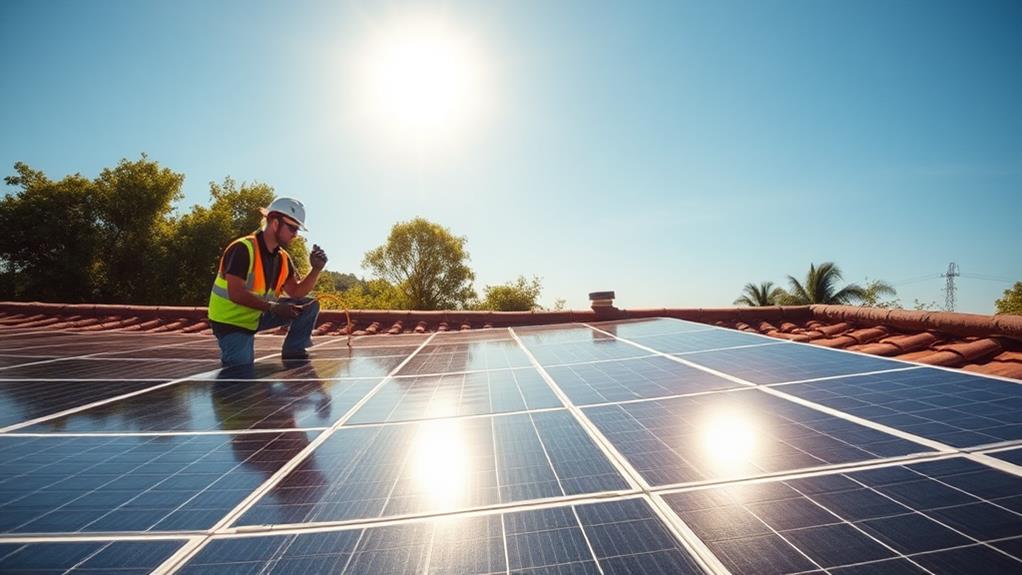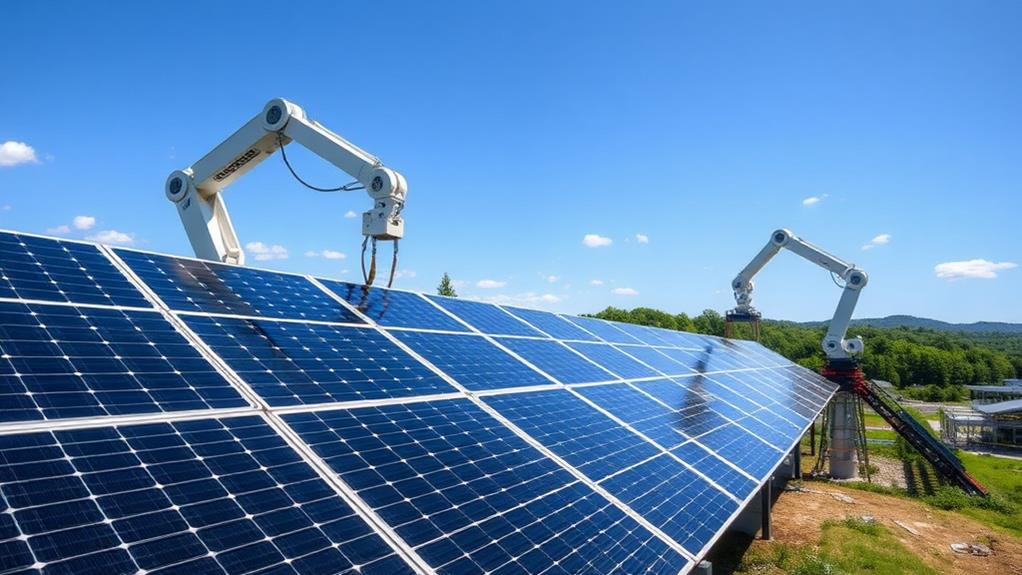When grounding solar panels, we should securely connect panel frames to the earth ground to prevent electrical shocks and protect against lightning strikes. It's crucial to link grounding holes directly to mounting brackets and maintain grounding resistance below 4 ohms for optimal efficiency. Using copper-coated ground rods buried at least 8 feet deep works well, especially when interconnected with bare copper wire. Regular maintenance and avoiding connections to hot or gas pipes help improve safety. Compliance with NEC regulations is vital to guarantee system performance. Let's investigate these methods further to improve our solar panel installations.
Key Takeaways
- Securely connect solar panel frames to earth ground to ensure safety and compliance.
- Link grounding holes directly to mounting brackets for effective grounding.
- Use copper-coated ground rods buried at least 8 feet deep for optimal conductivity.
- Connect multiple ground rods with bare copper wire, especially in arid areas.
- Avoid using hot or gas pipes for ground connections to prevent hazards.
Essential Grounding Techniques
When grounding solar panels, the panel frames must be securely connected to an earth ground. This connection is vital for preventing lightning damage and maintaining system safety. As a community focused on solar energy, effective grounding techniques are crucial to achieving these goals.
Proper solar panel grounding requires linking grounding holes on the panels directly to the mounting brackets. It's important to ensure the brackets themselves aren't solely relied upon for grounding. Coating treatments on mounting brackets can hinder effective grounding, so vigilance is necessary.
The grounding resistance should ideally be no more than 4Ω to maintain system efficiency and safety standards.
Aging solar panels, if not properly grounded, may develop leakage currents. These currents could result in system malfunctions, affecting not just individual setups but the broader network. Focusing on these essential grounding techniques contributes to a collective effort to optimise our systems.
Our solar investments should continue to shine bright, both individually and as part of a larger, interconnected energy community.
Safety Benefits of Grounding
Grounding systems are vital for enhancing the safety of solar panel installations. They aren't merely about compliance with grounding requirements or checking off items on the National Electric Code (NEC) checklist. Properly grounded solar panels significantly lower the risk of electrical shock from exposed metallic parts, creating safer environments for everyone involved, from installation technicians to homeowners.
Effective grounding acts as a safeguard against unpredictable natural forces, such as lightning strikes. It channels these powerful surges away from photovoltaic (PV) systems, preventing potential damage to critical components. This enhances system safety and prolongs the lifespan of the investment.
Grounding also reduces electrical surges, which can otherwise disrupt system functionality and efficiency.
Proper grounding minimises electrical noise, subtly yet significantly improving overall solar panel system performance. Adhering to NEC grounding requirements ensures systems operate smoothly, efficiently, and safely. Embracing these grounding benefits guarantees solar panels deliver the performance and security everyone deserves.
Compliance With Regulations
To ensure the safety and efficiency of our solar panel systems, adherence to regulations such as the National Electrical Code (NEC) is essential. These regulations serve as critical guidelines, ensuring proper solar panel grounding. Compliance with these standards enhances system safety and performance, providing reassurance and a sense of belonging to a community committed to excellence.
The NEC and other electrical codes specify grounding requirements. Meeting these requirements is essential to pass inspections and conform to legal standards. Compliance isn't optional; it's a vital responsibility.
Neglecting these regulations can lead to system malfunctions, create safety risks, and potentially result in legal repercussions. Understanding and following these regulatory requirements is crucial for a successful and code-compliant solar panel installation.
Effective Grounding Practices
Understanding compliance with regulations is crucial. Effective grounding practices ensure solar panel systems operate safely and efficiently. Grounding safety begins with the use of copper-coated ground rods. These should be buried at least 8 feet deep in moist soil to minimise ground resistance.
In arid areas, multiple ground rods spaced at least 10 feet apart are necessary. This configuration increases contact with the earth, thus achieving proper grounding.
Connecting all ground rods with bare copper wire (#6 or larger) is essential. This unifies the entire system, maintaining grounding safety. Burying these connections guards against accidental damage and prevents exposure to metallic objects that might disrupt the grounding path.
In rocky terrains where it's difficult to drive rods deep, burying at least 150 feet of bare copper wire can enhance the grounding system. Ground connections should only involve cold water pipes, avoiding hot or gas pipes. These practices ensure solar panels function reliably within communities.
For those seeking specific products, consider using the ERICO copper-coated ground rods for optimal performance. This choice supports the maintenance of a robust grounding system, vital for both safety and efficiency.
Common Grounding Challenges
In the realm of solar panel installations, inadequate grounding presents a significant challenge, often resulting in equipment damage and safety concerns. Many have faced grounding issues due to improper installation practices. Insufficient installation can expose us to poor soil conductivity, undermining system effectiveness. This isn't merely technical jargon—it concerns protecting our investments and ensuring community safety.
Corrosion and loose connections add another layer of complexity. Over time, they degrade the system, increasing ground resistance and risking grounding failures. Such failures can cause system malfunctions, electrical surges, and heightened vulnerability to lightning damage. The aspiration for seamless operation is widespread, yet these problems can disrupt this goal.
Regular maintenance, including inspection and testing, is vital to identify potential issues early. Addressing corrosion and securing connections can significantly enhance system reliability. Preventive measures shouldn't be underestimated.
In doing so, we can directly tackle these challenges, fostering a safer and more efficient solar panel community.
Conclusion
We've discussed the main methods and safety benefits of grounding solar panels. By understanding and using these techniques, we ensure that our solar installations comply with regulations and are as safe and effective as possible. Challenges may arise, but staying informed and proactive helps us tackle them efficiently. Let's commit to these grounding practices to protect our systems and promote a safer, more reliable solar energy future.
If you have any questions about our products, such as Rail-Less Solar Brackets, End Spacers, Structural Brackets, Ground Mounted Solar Systems, Corrugated Brackets, and Earthing Plates, or our services like the DeoSizer Tool, Evaluation and Design, Maintenance and Support, and Solar Installations, please feel free to contact us at Deo Solar. We are here to help you with your solar energy needs.

